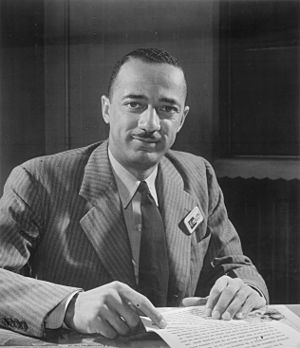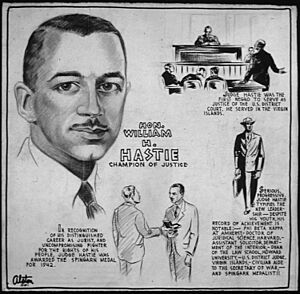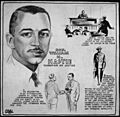William H. Hastie facts for kids
Quick facts for kids
William Hastie
|
|
|---|---|
 |
|
| Senior Judge of the United States Court of Appeals for the Third Circuit | |
| In office May 31, 1971 – April 14, 1976 |
|
| Judge of the United States Court of Appeals for the Third Circuit | |
| In office October 21, 1949 – May 31, 1971 |
|
| Appointed by | Harry S. Truman |
| Preceded by | Seat established |
| Succeeded by | James Rosen |
| Governor of the United States Virgin Islands | |
| In office May 17, 1946 – October 21, 1949 |
|
| Preceded by | Charles Harwood |
| Succeeded by | Morris Fidanque de Castro |
| Judge of the United States District Court of the Virgin Islands | |
| In office March 26, 1937 – July 1, 1939 |
|
| Appointed by | Franklin D. Roosevelt |
| Preceded by | George Jones |
| Succeeded by | Herman Moore |
| Personal details | |
| Born |
William Henry Hastie Jr.
November 17, 1904 Knoxville, Tennessee, U.S. |
| Died | April 14, 1976 (aged 71) East Norriton, Pennsylvania, U.S. |
| Political party | Democratic |
| Relations | Charles Hamilton Houston (cousin) |
| Education | Amherst College (BA) Harvard University (LLB, SJD) |
William Henry Hastie Jr. (born November 17, 1904 – died April 14, 1976) was an important American lawyer, judge, and public official. He also worked to make sure everyone had equal rights.
Hastie made history several times. He was the first African American to be the Governor of the United States Virgin Islands. He was also the first African American to serve as a federal judge and later as a judge on a higher federal court, called a federal appeals court. He served as a judge for the United States Court of Appeals for the Third Circuit and earlier as a judge for the District Court of the Virgin Islands.
Contents
William Hastie's Early Life and Education
William Hastie was born in Knoxville, Tennessee. His parents were William Henry Hastie Sr. and Roberta Childs. His family had African American and Native American roots. Some family stories even say one of his ancestors was a princess from Madagascar.
Hastie went to Dunbar High School in Washington, D.C. This school was known for its excellent academics for Black students. He then attended Amherst College in Massachusetts. He was a brilliant student, graduating at the top of his class with high honors. He earned a degree there.
Later, he studied law at Harvard Law School. He received his first law degree in 1930 and a higher law degree in 1933.
Hastie's Career in Law and Public Service
Early Legal Work
After law school, Hastie worked as a private lawyer in Washington, D.C., from 1930 to 1933. He then became an assistant for the United States Department of the Interior. In this role, from 1933 to 1937, he gave advice on issues related to race. He also worked with his second cousin, Charles Hamilton Houston, who was also a famous lawyer.
In 1937, President Franklin D. Roosevelt chose Hastie to be a judge for the District Court of the Virgin Islands. This made Hastie the first African American federal judge. This decision was quite new at the time.
In 1939, Hastie left his judge position. He became the head of the Howard University School of Law, where he had taught before. While teaching at Howard, he joined the Omega Psi Phi fraternity. One of his students was Thurgood Marshall, who later became a very important lawyer for the NAACP and a Supreme Court Justice.
Hastie and Thurgood Marshall worked together on a major case called Smith v. Allwright in 1944. In this case, the Supreme Court decided that "white primaries" were illegal. White primaries were elections where only white people were allowed to vote.
Service During World War II
During World War II, Hastie worked for the United States Secretary of War Henry Stimson from 1940 to 1942. He strongly believed that African Americans in the United States Army should be treated equally. He also pushed for them to be used fully in the war effort.
On January 15, 1943, Hastie resigned from his job. He did this to protest against unfair practices in the Army Air Forces. These included separate training places for Black and white soldiers and not enough training for African American pilots. That same year, he received the Spingarn Medal from the NAACP. This award recognized his achievements and his brave protest.
In 1946, President Harry S. Truman appointed Hastie as the Governor of the United States Virgin Islands. He was the first African American to hold this important position. Hastie served as governor from 1946 to 1949.
Federal Judicial Service
On October 21, 1949, President Harry S. Truman appointed Hastie to the United States Court of Appeals for the Third Circuit. This made him the first African American federal appeals court judge. The United States Senate approved his appointment on July 19, 1950. He officially started his new role on July 22, 1950.
Hastie served as a judge on this court until May 31, 1971, when he took on a "senior status" role. He also served as a judge for the Temporary Emergency Court of Appeals from 1972 until his death. William Hastie passed away on April 14, 1976, while playing golf in Philadelphia.
Considered for the Supreme Court
Because he was the first African American on a federal court, Hastie was considered as a possible candidate for the Supreme Court of the United States. If chosen, he would have been the first African American Justice on the Supreme Court.
In 1962, President John F. Kennedy thought about appointing Hastie to the Supreme Court. However, Kennedy decided not to. He believed that a Black appointee would face strong opposition from Southern senators. Kennedy said he expected to make more Supreme Court appointments later and planned to appoint Hastie then. However, Kennedy was assassinated before he could do so.
William Hastie's Legacy
William Hastie was a respected member of important groups like the American Academy of Arts and Sciences. The Third Circuit Library in Philadelphia is named in his honor. There is also a special room dedicated to him at The Beck Cultural Exchange Center in Knoxville, Tennessee, which keeps his personal papers. An urban natural area in South Knoxville is also named after him.
Hastie started as a young activist but grew into a calm and thoughtful judge. He believed that a judge should always be fair and neutral. He said that Black lawyers have played a very important role in the fight for equality in America. He showed his activism when he resigned from the War Department in 1943. He stated it was because of "unfair policies and practices in the Army and Air Forces."
Hastie's daughter, Karen Hastie Williams, also became a notable lawyer. She was the first woman of color to work as a clerk for a U.S. Supreme Court Justice.
See also
 In Spanish: William H. Hastie para niños
In Spanish: William H. Hastie para niños
- John F. Kennedy Supreme Court candidates
- List of African-American jurists
- List of first minority male lawyers and judges in the United States
Images for kids



